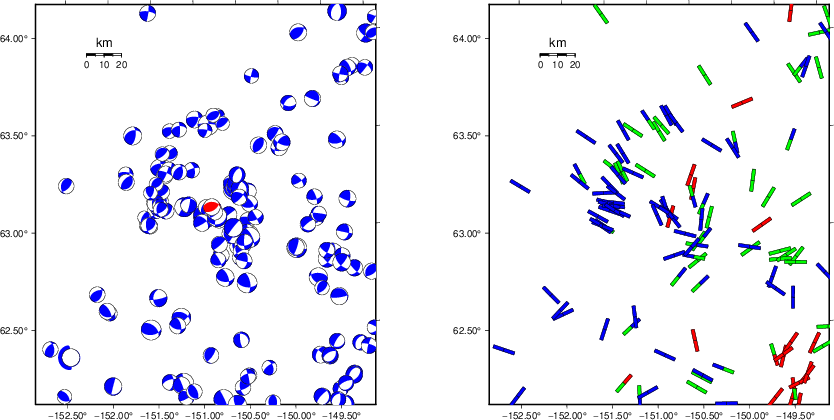Location
Location ANSS
The ANSS event ID is ak0258n34qy5 and the event page is at
https://earthquake.usgs.gov/earthquakes/eventpage/ak0258n34qy5/executive.
2025/07/07 10:24:12 63.120 -150.853 122.2 3.9 Alaska
Focal Mechanism
USGS/SLU Moment Tensor Solution
ENS 2025/07/07 10:24:12.0 63.12 -150.85 122.2 3.9 Alaska
Stations used:
AK.BPAW AK.CAST AK.CCB AK.DHY AK.GHO AK.H23K AK.HDA AK.I21K
AK.I23K AK.J20K AK.J25K AK.K24K AK.KNK AK.L22K AK.M20K
AK.MCK AK.MLY AK.NEA2 AK.PAX AK.POKR AK.PPLA AK.RND AK.SAW
AK.SCM AK.SKN AK.WAT6 AT.PMR AV.SPCL IM.IL31 IU.COLA
Filtering commands used:
cut o DIST/3.3 -40 o DIST/3.3 +50
rtr
taper w 0.1
hp c 0.03 n 3
lp c 0.10 n 3
Best Fitting Double Couple
Mo = 2.19e+22 dyne-cm
Mw = 4.16
Z = 120 km
Plane Strike Dip Rake
NP1 60 55 70
NP2 272 40 116
Principal Axes:
Axis Value Plunge Azimuth
T 2.19e+22 72 279
N 0.00e+00 16 72
P -2.19e+22 8 164
Moment Tensor: (dyne-cm)
Component Value
Mxx -1.98e+22
Mxy 5.30e+21
Mxz 3.94e+21
Myy 4.79e+20
Myz -7.23e+21
Mzz 1.93e+22
--------------
----------------------
----------------------------
------------------------------
-----------##########-------------
-------#####################--------
-----###########################-----#
---#################################-###
--##################################--##
-############## ##################----##
############### T #################------#
############### ################--------
################################----------
#############################-----------
##########################--------------
######################----------------
#################-------------------
----------------------------------
------------------------------
----------------------------
--------------- ----
----------- P
Global CMT Convention Moment Tensor:
R T P
1.93e+22 3.94e+21 7.23e+21
3.94e+21 -1.98e+22 -5.30e+21
7.23e+21 -5.30e+21 4.79e+20
Details of the solution is found at
http://www.eas.slu.edu/eqc/eqc_mt/MECH.NA/20250707102412/index.html
|
Preferred Solution
The preferred solution from an analysis of the surface-wave spectral amplitude radiation pattern, waveform inversion or first motion observations is
STK = 60
DIP = 55
RAKE = 70
MW = 4.16
HS = 120.0
The NDK file is 20250707102412.ndk
The waveform inversion is preferred.
Magnitudes
Given the availability of digital waveforms for determination of the moment tensor, this section documents the added processing leading to mLg, if appropriate to the region, and ML by application of the respective IASPEI formulae. As a research study, the linear distance term of the IASPEI formula
for ML is adjusted to remove a linear distance trend in residuals to give a regionally defined ML. The defined ML uses horizontal component recordings, but the same procedure is applied to the vertical components since there may be some interest in vertical component ground motions. Residual plots versus distance may indicate interesting features of ground motion scaling in some distance ranges. A residual plot of the regionalized magnitude is given as a function of distance and azimuth, since data sets may transcend different wave propagation provinces.
ML Magnitude

Left: ML computed using the IASPEI formula for Horizontal components. Center: ML residuals computed using a modified IASPEI formula that accounts for path specific attenuation; the values used for the trimmed mean are indicated. The ML relation used for each figure is given at the bottom of each plot.
Right: Residuals from new relation as a function of distance and azimuth.

Left: ML computed using the IASPEI formula for Vertical components (research). Center: ML residuals computed using a modified IASPEI formula that accounts for path specific attenuation; the values used for the trimmed mean are indicated. The ML relation used for each figure is given at the bottom of each plot.
Right: Residuals from new relation as a function of distance and azimuth.
Context
The left panel of the next figure presents the focal mechanism for this earthquake (red) in the context of other nearby events (blue) in the SLU Moment Tensor Catalog. The right panel shows the inferred direction of maximum compressive stress and the type of faulting (green is strike-slip, red is normal, blue is thrust; oblique is shown by a combination of colors). Thus context plot is useful for assessing the appropriateness of the moment tensor of this event.
Waveform Inversion using wvfgrd96
The focal mechanism was determined using broadband seismic waveforms. The location of the event (star) and the
stations used for (red) the waveform inversion are shown in the next figure.
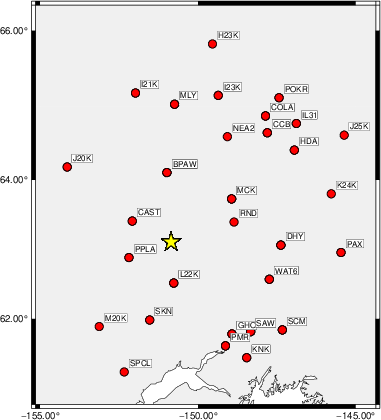
|
|
Location of broadband stations used for waveform inversion
|
The program wvfgrd96 was used with good traces observed at short distance to determine the focal mechanism, depth and seismic moment. This technique requires a high quality signal and well determined velocity model for the Green's functions. To the extent that these are the quality data, this type of mechanism should be preferred over the radiation pattern technique which requires the separate step of defining the pressure and tension quadrants and the correct strike.
The observed and predicted traces are filtered using the following gsac commands:
cut o DIST/3.3 -40 o DIST/3.3 +50
rtr
taper w 0.1
hp c 0.03 n 3
lp c 0.10 n 3
The results of this grid search are as follow:
DEPTH STK DIP RAKE MW FIT
WVFGRD96 2.0 100 45 -90 3.32 0.1947
WVFGRD96 4.0 270 75 -75 3.35 0.1592
WVFGRD96 6.0 275 80 -75 3.35 0.2050
WVFGRD96 8.0 150 20 -35 3.45 0.2318
WVFGRD96 10.0 135 65 60 3.51 0.2584
WVFGRD96 12.0 165 55 55 3.55 0.2806
WVFGRD96 14.0 165 50 45 3.57 0.2874
WVFGRD96 16.0 165 50 45 3.60 0.2879
WVFGRD96 18.0 165 50 45 3.62 0.2833
WVFGRD96 20.0 165 50 45 3.64 0.2741
WVFGRD96 22.0 205 35 45 3.66 0.2638
WVFGRD96 24.0 230 40 50 3.68 0.2557
WVFGRD96 26.0 230 40 50 3.70 0.2458
WVFGRD96 28.0 235 45 60 3.71 0.2354
WVFGRD96 30.0 240 45 70 3.72 0.2266
WVFGRD96 32.0 205 45 -70 3.75 0.2420
WVFGRD96 34.0 205 45 -70 3.79 0.2751
WVFGRD96 36.0 205 45 -75 3.81 0.2991
WVFGRD96 38.0 205 45 -75 3.83 0.3092
WVFGRD96 40.0 260 50 -85 3.93 0.3084
WVFGRD96 42.0 200 45 -75 3.97 0.3081
WVFGRD96 44.0 265 50 -75 3.98 0.2989
WVFGRD96 46.0 265 50 -75 4.00 0.2921
WVFGRD96 48.0 265 50 -75 4.00 0.2839
WVFGRD96 50.0 240 55 65 3.99 0.2792
WVFGRD96 52.0 245 55 70 4.01 0.2893
WVFGRD96 54.0 250 35 75 4.01 0.3111
WVFGRD96 56.0 250 35 80 4.03 0.3422
WVFGRD96 58.0 250 35 85 4.05 0.3684
WVFGRD96 60.0 70 50 85 4.06 0.3948
WVFGRD96 62.0 65 50 80 4.07 0.4183
WVFGRD96 64.0 65 45 80 4.07 0.4366
WVFGRD96 66.0 65 45 80 4.08 0.4574
WVFGRD96 68.0 65 45 80 4.08 0.4777
WVFGRD96 70.0 60 50 75 4.09 0.4982
WVFGRD96 72.0 60 50 75 4.09 0.5184
WVFGRD96 74.0 60 50 75 4.09 0.5376
WVFGRD96 76.0 60 50 70 4.10 0.5551
WVFGRD96 78.0 60 50 70 4.10 0.5723
WVFGRD96 80.0 60 55 70 4.11 0.5894
WVFGRD96 82.0 60 55 70 4.12 0.6060
WVFGRD96 84.0 60 55 70 4.12 0.6205
WVFGRD96 86.0 60 55 70 4.12 0.6327
WVFGRD96 88.0 60 55 70 4.13 0.6447
WVFGRD96 90.0 60 55 70 4.13 0.6562
WVFGRD96 92.0 60 55 70 4.13 0.6655
WVFGRD96 94.0 60 55 70 4.13 0.6736
WVFGRD96 96.0 60 55 70 4.14 0.6806
WVFGRD96 98.0 60 55 70 4.14 0.6869
WVFGRD96 100.0 60 55 70 4.14 0.6925
WVFGRD96 102.0 60 55 70 4.14 0.6971
WVFGRD96 104.0 60 55 70 4.15 0.7010
WVFGRD96 106.0 60 55 70 4.15 0.7048
WVFGRD96 108.0 60 55 70 4.15 0.7069
WVFGRD96 110.0 60 55 70 4.15 0.7095
WVFGRD96 112.0 60 55 70 4.15 0.7110
WVFGRD96 114.0 60 55 70 4.16 0.7123
WVFGRD96 116.0 60 55 70 4.16 0.7147
WVFGRD96 118.0 60 55 70 4.16 0.7144
WVFGRD96 120.0 60 55 70 4.16 0.7151
WVFGRD96 122.0 60 55 70 4.17 0.7143
WVFGRD96 124.0 60 50 70 4.16 0.7138
WVFGRD96 126.0 60 50 70 4.16 0.7137
WVFGRD96 128.0 60 50 70 4.17 0.7126
WVFGRD96 130.0 60 50 70 4.17 0.7112
WVFGRD96 132.0 60 50 70 4.17 0.7089
WVFGRD96 134.0 60 50 70 4.17 0.7079
WVFGRD96 136.0 60 50 70 4.18 0.7057
WVFGRD96 138.0 60 50 70 4.18 0.7035
WVFGRD96 140.0 60 50 70 4.18 0.7006
WVFGRD96 142.0 60 50 70 4.18 0.6987
WVFGRD96 144.0 60 50 70 4.18 0.6960
WVFGRD96 146.0 60 50 70 4.19 0.6931
WVFGRD96 148.0 60 50 70 4.19 0.6913
The best solution is
WVFGRD96 120.0 60 55 70 4.16 0.7151
The mechanism corresponding to the best fit is
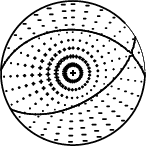
|
|
Figure 1. Waveform inversion focal mechanism
|
The best fit as a function of depth is given in the following figure:
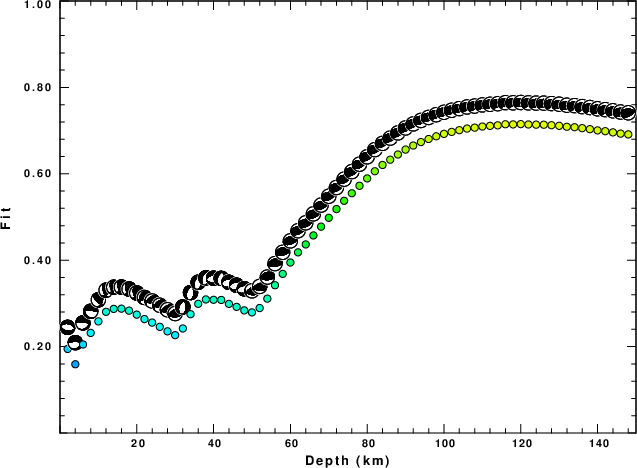
|
|
Figure 2. Depth sensitivity for waveform mechanism
|
The comparison of the observed and predicted waveforms is given in the next figure. The red traces are the observed and the blue are the predicted.
Each observed-predicted component is plotted to the same scale and peak amplitudes are indicated by the numbers to the left of each trace. A pair of numbers is given in black at the right of each predicted traces. The upper number it the time shift required for maximum correlation between the observed and predicted traces. This time shift is required because the synthetics are not computed at exactly the same distance as the observed, the velocity model used in the predictions may not be perfect and the epicentral parameters may be be off.
A positive time shift indicates that the prediction is too fast and should be delayed to match the observed trace (shift to the right in this figure). A negative value indicates that the prediction is too slow. The lower number gives the percentage of variance reduction to characterize the individual goodness of fit (100% indicates a perfect fit).
The bandpass filter used in the processing and for the display was
cut o DIST/3.3 -40 o DIST/3.3 +50
rtr
taper w 0.1
hp c 0.03 n 3
lp c 0.10 n 3

|
|
Figure 3. Waveform comparison for selected depth. Red: observed; Blue - predicted. The time shift with respect to the model prediction is indicated. The percent of fit is also indicated. The time scale is relative to the first trace sample.
|
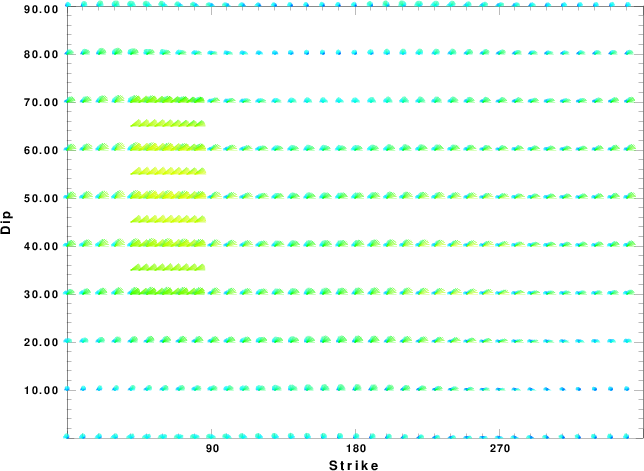
|
|
Focal mechanism sensitivity at the preferred depth. The red color indicates a very good fit to the waveforms.
Each solution is plotted as a vector at a given value of strike and dip with the angle of the vector representing the rake angle, measured, with respect to the upward vertical (N) in the figure.
|
A check on the assumed source location is possible by looking at the time shifts between the observed and predicted traces. The time shifts for waveform matching arise for several reasons:
- The origin time and epicentral distance are incorrect
- The velocity model used for the inversion is incorrect
- The velocity model used to define the P-arrival time is not the
same as the velocity model used for the waveform inversion
(assuming that the initial trace alignment is based on the
P arrival time)
Assuming only a mislocation, the time shifts are fit to a functional form:
Time_shift = A + B cos Azimuth + C Sin Azimuth
The time shifts for this inversion lead to the next figure:
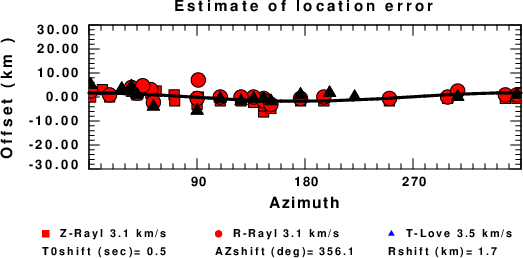
The derived shift in origin time and epicentral coordinates are given at the bottom of the figure.
Velocity Model
The WUS.model used for the waveform synthetic seismograms and for the surface wave eigenfunctions and dispersion is as follows
(The format is in the model96 format of Computer Programs in Seismology).
MODEL.01
Model after 8 iterations
ISOTROPIC
KGS
FLAT EARTH
1-D
CONSTANT VELOCITY
LINE08
LINE09
LINE10
LINE11
H(KM) VP(KM/S) VS(KM/S) RHO(GM/CC) QP QS ETAP ETAS FREFP FREFS
1.9000 3.4065 2.0089 2.2150 0.302E-02 0.679E-02 0.00 0.00 1.00 1.00
6.1000 5.5445 3.2953 2.6089 0.349E-02 0.784E-02 0.00 0.00 1.00 1.00
13.0000 6.2708 3.7396 2.7812 0.212E-02 0.476E-02 0.00 0.00 1.00 1.00
19.0000 6.4075 3.7680 2.8223 0.111E-02 0.249E-02 0.00 0.00 1.00 1.00
0.0000 7.9000 4.6200 3.2760 0.164E-10 0.370E-10 0.00 0.00 1.00 1.00
Last Changed Mon Jul 7 08:21:35 CDT 2025


